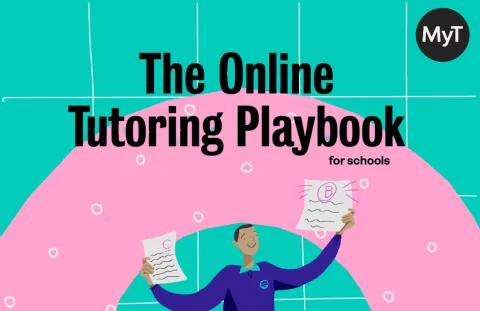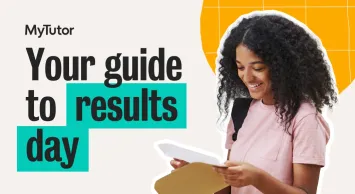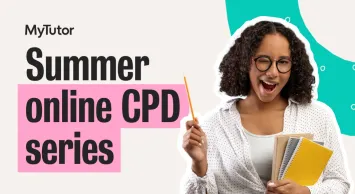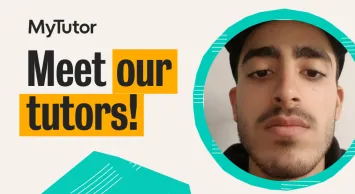Top tips for successfully embedding online tutoring in your school
With the new academic year underway, many schools are turning their attention to launching tutoring programmes to best support their pupils. As a universally recognised method of addressing low attainment and educational inequality, embedding tutoring in your learning programme is an essential and proven way to close the attainment gap.
Tutoring doesn’t only boost grades however, it’s also a fantastic way to improve confidence, engagement with learning and achievement. When implementing programmes, how do schools make sure they’re making the most of tutoring and really driving impact?
That’s where we’re here to help! Here we run through our 5 top tips for embedding tutoring in your school, inspired by our partner schools, that will set your programmes up for success.
1. Choose your pupils wisely
Our first top tip is to define the goals of your tutoring programme and to be targeted in choosing which pupils will benefit most. It’s important to think carefully about who your tutoring programmes are for and what you’re trying to achieve - without this, it will be hard to measure success later on.
“Choose your students wisely. Who’s going to engage best with tutoring?” St John Payne School
So, how do you choose which children get online tutoring?
This is an important question and one that schools may answer differently. You may choose to give tutoring solely to disadvantaged pupils, for example, Pupil Premium pupils, with the goal of closing the attainment gap or preventing pupils from falling further behind post-pandemic.
Alternatively, some schools choose pupils who are on the cusp of hitting their grades and need an extra push, or others will focus their support on high-achievers who are aiming to get into top universities. The important thing is to select pupils based on your overarching goal.
And remember, who you choose may change throughout the year and that’s ok. Some pupils will benefit more from a targeted programme to build confidence before exams, while others will need support combating the ‘summer slide’.
Here’s what our partner schools are saying:
“When we were introduced to MyTutor, we took a data-driven approach to choosing the students, identifying what we referred to as ‘key tipper’ students – those that we believed could make the transition from those 2s and 3s to 4s, 5s or above.” Ryde Academy
“When selecting students for the programme, we started with our most vulnerable, disadvantaged students – those in receipt of the pupil premium grant, children with special educational needs or disabilities (SEND), looked after children, or those under social care. Within that group, we then looked at those with the biggest learning gaps, and identified 3:1 groups based on common gaps in knowledge.” Basildon Academies Trust
2. Get whole school buy-in
Our next tip is to ensure that the whole school is bought into the tutoring programme from the start. This means senior leaders, pupils, and parents and guardians (more on that below!).
Many schools choose to run an assembly to introduce the programme, which gives the opportunity to build excitement and explain clearly what the goals are and why. It’s also important to communicate the programme in a way that makes pupils feel supported, rather than punished for falling behind. Some schools choose to frame it as ‘out-of-hours learning’ to make sure it isn’t seen as additional homework.
To further promote your programme schoolwide and get buy-in, we recommend:
- Schoolwide communications: Newsletters, postcards home and even posters around the school clearly communicate what your programme is and why you're running it to everyone.
- Pupil leaderboards: Who doesn’t want to be top of the leaderboard? Motivate pupils with some friendly competition and keep the school engaged.
- Nominate a tutoring lead: A tutoring lead who is in charge of monitoring the programme, sharing best practices and championing the programme across the school is invaluable.
- Find tutoring champions: Whether you choose pupils or teachers, champions will promote the programme schoolwide, amplifying the positive effects of tutoring.
Here’s what our partner schools have been doing to get buy-in on their programmes:
“My advice to any other schools considering using MyTutor would be to lean into it. If you take steps to really embed the programme – we did an assembly on it, we called and wrote letters home to parents, the Headteacher sent texts to students to remind them of lessons – then you’ll see the true impact.” Lodge Park Academy
“This year we have introduced the concept of ‘leaderboards’ to accelerate school and pupil-level engagement in tutoring.” Academies Enterprise Trust
You can find more insights and advice in our Online Tutoring Playbook, get your free copy here.

3. Involve parents and guardians
Getting parents and guardians bought in and involved with tutoring is another fantastic way to truly embed the practice in your learning programme.
Parents who are supportive of tutoring and who encourage their child's participation can help boost engagement. Who hasn’t needed a parent or guardian to remind them to do something from time to time, or offer a little encouragement to help them stay on track?
Again, as we know for some pupils, if it’s not introduced properly, tutoring can feel like a punishment for falling behind rather than a way to help them get ahead. It’s important that the message coming from a pupil's home aligns with the school's. This makes sure that pupils see the positives in the programme and feel motivated. Having an embedded tutoring programme can also demonstrate to parents that a school is being proactive in helping their child.
Here’s what our partner schools have to say about getting parents involved:
“To engage parents, I’ve also recorded my own instructional video about MyTutor, what it is and how it all works. We’ve moved to a video approach because when you send a letter, with our parents, we’ve found that they don’t engage particularly well – whereas video, with a personal touch from someone they know, works really well.” Ryde Academy
“Encourage parents to get involved as much as possible. I do this by sending ePostcards home, which include key information to parents and carers prior to their child starting tuition, to encourage parents to talk with their children about school. The difference in student engagement when parents and carers have been involved and engaged has been huge.” Farlingaye High School
What's more, we have lots of further resources in our new Onboarding Hub that supports schools to reach parents and guardians.
4. Make sure your teachers and tutors are aligned
Schools often ask us how we make sure tutors and teachers are aligned. It’s an important question, given that tutoring should be working to support teachers in their classrooms and that strong tutor-pupil and tutor-teacher relationships lead to better outcomes.
Here at MyTutor, we’re bridging the gap between tutors and teachers in a number of ways. Our tutors provide progress reports to help teachers see pupils' progress as the programme runs. We also carefully select tutors who are near-peers, having recently done exams themselves, to make sure they have up-to-date and relatable knowledge in their subjects.
On top of this, tutors are carefully trained by us and further equipped with the expertise from teachers on what gaps in knowledge each pupil is working on. Because we know that tutoring is most effective when it’s explicitly linked to classroom learning, this is an essential part of embedding tutoring in your school.
A tutoring lead can also be a valuable resource here, as they share best practices across the school or MAT and keep track of progress to make sure that everyone is aligned throughout the programme.
Here’s what our schools had to say:
“The tutors are very independent. We found that, once we provided good-quality information up-front, the tutors were able to take that and run with it.” Basildon Academies Trust
“Each school appointed a Tutoring Lead, and the Leads came together in a core group to share best practices and to explore implementation methods.” Bohunt Education Trust
“Schools who appointed a tutoring ‘champion’ saw better results. We tackled this by sharing the successes of the programme – some of our schools’ results at grades 4+ and 5+ leapt by double digits for instance.” Academies Enterprise Trust
5. Celebrate your successes
Last but by no means least, we always recommend that schools celebrate the successes of their programmes and pupils throughout the year. This way, everyone gets to see the positive work being achieved by your pupils.
With well-outlined goals, it’s simple to measure the success of tutoring. Whether that’s through monitoring pupil progress through attendance, punctuality, lessons completed or by impact on grades - there are many ways to record the success of your tutoring programme.
Outside of assessments, many teachers tell us that they observe a behavioural improvement in their students - they’re more confident, more motivated, and have higher aspirations. While that can be harder to measure, it’s certainly worth celebrating nonetheless!
So don’t forget to shout about your achievements, whether that’s in assemblies, newsletters or on results day!
Here’s what our schools had to say:
“When you talk to the students, they certainly feel like the tuition has had an impact; the majority agreed that it’s been very useful for them. Lots of them say they feel more confident and that they’ve made more progress in their subjects as a result.” Basildon Academies Trust
“Celebrate the tuition programme wider in the school - make sure it’s communicated and well known amongst the staff body and students to get that buy-in.” The City of Leicester College
Embedding tutoring in your school has lasting benefits for your learners. We hope these top tips will help you maximise the impact of tutoring in your school this year.
If you’d like further advice, book a call with our expert team. We're happy to talk you through best practices in online tutoring, maximising your funding pots and answer any further questions you may have. Simply book a call with us, today!


